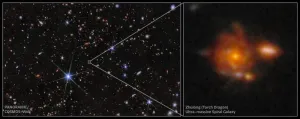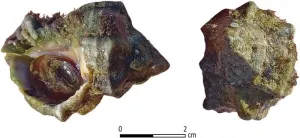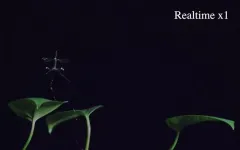(Press-News.org) Astronomers have detected the most promising signs yet of a possible biosignature outside the solar system, although they remain cautious.
Using data from the James Webb Space Telescope (JWST), the astronomers, led by the University of Cambridge, have detected the chemical fingerprints of dimethyl sulfide (DMS) and/or dimethyl disulfide (DMDS), in the atmosphere of the exoplanet K2-18b, which orbits its star in the habitable zone.
On Earth, DMS and DMDS are only produced by life, primarily microbial life such as marine phytoplankton. While an unknown chemical process may be the source of these molecules in K2-18b’s atmosphere, the results are the strongest evidence yet that life may exist on a planet outside our solar system.
The observations have reached the ‘three-sigma’ level of statistical significance – meaning there is a 0.3% probability that they occurred by chance. To reach the accepted classification for scientific discovery, the observations would have to cross the five-sigma threshold, meaning there would be below a 0.00006% probability they occurred by chance.
The researchers say between 16 and 24 hours of follow-up observation time with JWST may help them reach the all-important five-sigma significance. Their results are reported in The Astrophysical Journal Letters.
Earlier observations of K2-18b — which is 8.6 times as massive and 2.6 times as large as Earth, and lies 124 light years away in the constellation of Leo — identified methane and carbon dioxide in its atmosphere. This was the first time that carbon-based molecules were discovered in the atmosphere of an exoplanet in the habitable zone. Those results were consistent with predictions for a ‘Hycean’ planet: a habitable ocean-covered world underneath a hydrogen-rich atmosphere.
However, another, weaker signal hinted at the possibility of something else happening on K2-18b. “We didn’t know for sure whether the signal we saw last time was due to DMS, but just the hint of it was exciting enough for us to have another look with JWST using a different instrument,” said Professor Nikku Madhusudhan from Cambridge’s Institute of Astronomy, who led the research.
To determine the chemical composition of the atmospheres of faraway planets, astronomers analyse the light from its parent star as the planet transits, or passes in front of the star as seen from the Earth. As K2-18b transits, JWST can detect a drop in stellar brightness, and a tiny fraction of starlight passes through the planet’s atmosphere before reaching Earth. The absorption of some of the starlight in the planet’s atmosphere leaves imprints in the stellar spectrum that astronomers can piece together to determine the constituent gases of the exoplanet’s atmosphere.
The earlier, tentative, inference of DMS was made using JWST’s NIRISS (Near-Infrared Imager and Slitless Spectrograph) and NIRSpec (Near-Infrared Spectrograph) instruments, which together cover the near-infrared (0.8-5 micron) range of wavelengths. The new, independent observation used JWST’s MIRI (Mid-Infrared Instrument) in the mid-infrared (6-12 micron) range.
“This is an independent line of evidence, using a different instrument than we did before and a different wavelength range of light, where there is no overlap with the previous observations,” said Madhusudhan. “The signal came through strong and clear.”
“It was an incredible realisation seeing the results emerge and remain consistent throughout the extensive independent analyses and robustness tests,” said co-author Måns Holmberg, a researcher at the Space Telescope Science Institute in Baltimore, USA.
DMS and DMDS are molecules from the same chemical family, and both are predicted to be biosignatures. Both molecules have overlapping spectral features in the observed wavelength range, although further observations will help differentiate between the two molecules.
However, the concentrations of DMS and DMDS in K2-18b’s atmosphere are very different than on Earth, where they are generally below one part per billion by volume. On K2-18b, they are estimated to be thousands of times stronger - over ten parts per million.
“Earlier theoretical work had predicted that high levels of sulfur-based gases like DMS and DMDS are possible on Hycean worlds,” said Madhusudhan. “And now we’ve observed it, in line with what was predicted. Given everything we know about this planet, a Hycean world with an ocean that is teeming with life is the scenario that best fits the data we have.”
Madhusudhan says that while the results are exciting, it’s vital to obtain more data before claiming that life has been found on another world. He says that while he is cautiously optimistic, there could be previously unknown chemical processes at work on K2-18b that may account for the observations. Working with colleagues, he is hoping to conduct further theoretical and experimental work to determine whether DMS and DMDS can be produced non-biologically at the level currently inferred.
“The inference of these biosignature molecules poses profound questions concerning the processes that might be producing them” said co-author Subhajit Sarkar of Cardiff University.
“Our work is the starting point for all the investigations that are now needed to confirm and understand the implications of these exciting findings,” said co-author Savvas Constantinou, also from Cambridge’s Institute of Astronomy.
“It’s important that we’re deeply sceptical of our own results, because it’s only by testing and testing again that we will be able to reach the point where we’re confident in them,” Madhusudhan said. “That’s how science has to work.”
While he is not yet claiming a definitive discovery, Madhusudhan says that with powerful tools like JWST and future planned telescopes, humanity is taking new steps toward answering that most essential of questions: are we alone?
“Decades from now, we may look back at this point in time and recognise it was when the living universe came within reach,” said Madhusudhan. “This could be the tipping point, where suddenly the fundamental question of whether we’re alone in the universe is one we’re capable of answering.”
The James Webb Space Telescope is a collaboration between NASA, ESA and the Canadian Space Agency (CSA). The research is supported by a UK Research and Innovation (UKRI) Frontier Research Grant.
To learn more about Hycean worlds, visit hycean.group.cam.ac.uk.
END
Strongest hints yet of biological activity outside the solar system
2025-04-16
ELSE PRESS RELEASES FROM THIS DATE:
Children face ‘lifelong psychological wounds’ from entrenched inequities made worse by pandemic, doctor warns
2025-04-16
The COVID-19 pandemic deepened existing health disparities and thrust children into a mental health epidemic, altering the landscape of health and wellbeing for a generation.
This is the stark warning of Dr Jatinder Hayre in his critical analysis of ‘entrenched inequities’ in the UK, The Lost Generation of COVID-19.
He presents a breadth of research to set out how, after a prolonged period of cuts to UK public services, Britain’s struggle with COVID-19 has fundamentally reshaped its social, economic, and health landscape. Dr Hayre, who led the Independent ...
New research reveals socio-economic influences on how the body regulates eating
2025-04-16
Published in the journal Food Quality and Preference, the research highlights how physiological signals, particularly those transmitted via the vagus nerve, interact with socio-economic factors to shape dietary behaviour.
The study involved 96 students from diverse socio-economic backgrounds who participated in a chocolate tasting session.
In a controlled laboratory setting, each participant was presented with a plate containing 70 milk chocolate pieces and invited to sample and rate them at their leisure.
Researchers measured each student's heart rate variability (HRV) as a proxy for ...
Unhealthy metabolic profile sharply increases risk of breast cancer returning and subsequent death from breast cancer among those who have survived the disease
2025-04-16
New research to be presented at this year’s European Congress on Obesity (ECO 2025, Malaga, Spain, 11-14 May) and published in The Journal of Internal Medicine shows that, in survivors of breast cancer, having an unhealthy metabolic profile or so called ‘metabolic syndrome’ increases the risk of breast cancer recurrence by 69%, and subsequent breast cancer mortality by 83%. The study is by Dr Sixten Harborg, Department of Oncology, Aarhus University/Aarhus University Hospital, Aarhus, ...
Marine radar can accurately monitor vessel speeds to protect whales, study finds
2025-04-16
A new study by researchers at ProtectedSeas highlights the potential of marine radar technology to monitor speed of small vessels. The research, aimed at testing the accuracy of radar in assessing potential violations, found that the technology could detect speed violations with 95% confidence, offering a promising solution to help reduce the threat of vessel strikes on whale populations. The analysis was recently published in the journal Sensors.
The impact of small vessels on whales is becoming a growing concern in busy marine environments due to the increasing number ...
National Center to Reframe Aging teams up with West End Home Foundation
2025-04-16
The National Center to Reframe Aging — the leading organization for proven communication strategies and tools to effectively frame aging issues — is partnering with The West End Home Foundation (WEHF), an independent charitable foundation located in Nashville, Tennessee.
The National Center to Reframe Aging will be a strategic partner to support the WEHF’s mission to enrich the lives of older people through grant making, advocacy, and community collaboration. Key leaders of the Tennessee Department of Disability and Aging and the Tennessee aging network will participate in educational opportunities and receive tools from the National Center ...
How do age, sex, hormones and genetics affect dementia biomarkers in the blood?
2025-04-16
EMBARGOED FOR RELEASE UNTIL 4:00 P.M. ET, WEDNESDAY, APRIL 16, 2025
MINNEAPOLIS — A new study has found important clues about the roles age, sex, hormonal changes and genetics play in how certain biomarkers for dementia are expressed in the blood, according to a study published on April 16, 2025, online in Neurology®, the medical journal of the American Academy of Neurology.
“Blood tests that detect biomarkers for Alzheimer's disease and other dementias are emerging and as these tests are further developed, they are becoming important tools for understanding and diagnosing ...
NSF NOIRLab astronomer discovers oldest known spiral galaxy in the Universe
2025-04-16
Large, grand-design spiral galaxies like our own Milky Way are common in the nearby Universe. But they have proven hard to find in the early Universe, which is consistent with expectations that large disks with spiral arms should take many billions of years to form. However, assistant astronomer Christina Williams of NSF NOIRLab, which is funded by the U.S. National Science Foundation, has discovered a surprisingly mature spiral galaxy just one billion years after the Big Bang [1]. This is the most distant, earliest known ...
Iron Age purple dye "factory" in Israel was in operation for almost 500 years, using mollusks in large-scale specialized manufacturing process
2025-04-16
Iron Age purple dye "factory" in Israel was in operation for almost 500 years, using mollusks in large-scale specialized manufacturing process
Article URL: https://plos.io/44elLDX
Article title: Tel Shiqmona during the Iron Age: A first glimpse into an ancient Mediterranean purple dye ‘factory’
Author countries: U.S., Israel
Funding: The author(s) received no specific funding for this work. END ...
Even vegans who get enough total protein may fall short for some essential amino acids
2025-04-16
In a new study of people with long-term vegan diets, most ate an adequate amount of total daily protein, but a significant proportion did not meet required levels of the amino acids lysine and leucine. Bi Xue Patricia Soh and colleagues at Massey University, New Zealand, present these findings in the open-access journal PLOS One on April 16, 2025.
Proteins are made up of various molecular “building blocks” known as amino acids. While the human body can synthesize most of the amino acids we need to live, we completely rely on the ...
RoboBee comes in for a landing
2025-04-16
The Harvard RoboBee has long shown it can fly, dive, and hover like a real insect. But what good is the miracle of flight without a safe way to land?
A storied engineering achievement by the Harvard Microrobotics Laboratory, the RoboBee is now outfitted with its most reliable landing gear to date, inspired by one of nature’s most graceful landers: the crane fly.
Publishing in Science Robotics, the team led by Robert Wood, the Harry Lewis and Marlyn McGrath Professor of Engineering and Applied Sciences in the John A. Paulson School ...






